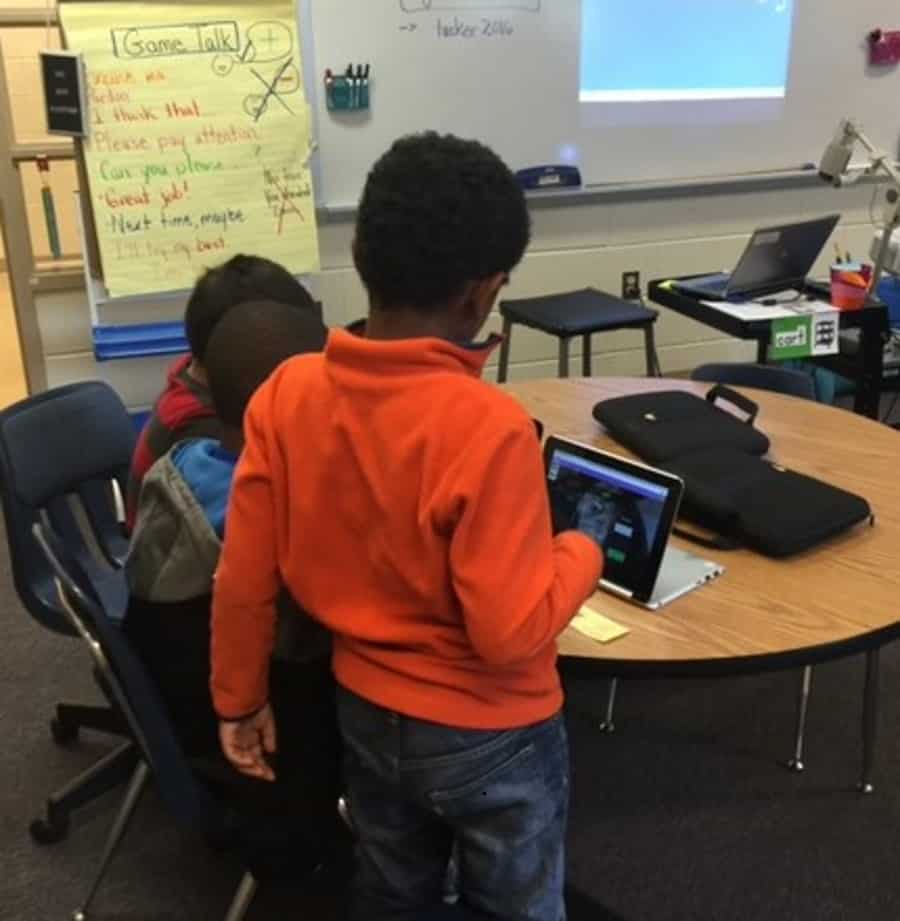
Mobile learning is a great tool and resource. With ever-increasing technological capabilities, it only makes sense that students of all ages have moved to online resources for help with everything from math to history to language. Mobile language learning is an exciting topic to teach remotely because it focuses on communication. But will it change language learning?
Mobile learning has already changed language learning and studies show that the early results are positive. Some traditional classroom methods have give way to more flexible learning. However, it does have less direct human interaction, which can lead to a decrease in crucial motivation.
Mobile learning is not likely to go away so long as technology continues to add conveniences to lives. That being said, there is still a lot to research and understand when it comes to the pros and cons of utilizing it for language learning. Keep reading to learn more about how language learning can benefit and be negatively affected by mobile learning’s attempts to bridge the distances between us.
Contents
- 1 Effects of Mobile Language Learning
- 2 How Mobile Language Learning Works
- 3 Mobile Language Learning Has Benefits
- 4 Mobile Language Learning Has Drawbacks
- 5 The Rise of Mobile Language Learning
- 6 Mobile Language Learning is Here to Stay
- 7 The Final Talking Point on Mobile Learning Changes to Language Learning
Effects of Mobile Language Learning
While mobile language learning has been around for some time now, there is a surprising lack of concrete, scientific data about how it has impacted traditional language learning. It is hard to gauge just how the increase in mobile learning has affected students.
Mobile Learning Offers Greater Fun
It seems apparent that mobile language learning is, on the whole, improving the desire to learn another language. If nothing else, the availability of mobile language learning has increased the likelihood that a child or adult who was raised to speak English might want to learn another language for fun.
As a former language specialist in public schools, I know just how valuable fun is to motivating students to learn. If you’d like to read more about motivation and learning, I’ve addressed it extensively here.
In addition, there is now current research to support fun in learning for adults, just as much as children.
While the benefits of learning for fun should not be discounted, mobile language learning does have some significant drawbacks. Languages exist to allow humans to communicate and, without the presence of another human, something is fundamentally missing in the learned language.
People who rely solely on language learning apps miss out on slang terms, colloquialisms, word connotations, body language associated with phrases, and other essential cultural connotations that go hand-in-hand with a language. Mobile learning can never fully replace a human speaking partner or teacher when it comes to languages.
This also goes for the personal interaction that comes with speaking with native speakers and practicing a language in ‘real time’ and in person. Benny Lewis is a polyglot, author, and famous advocate of the ‘speak from day one approach’. Mobile learning can be fun, but so can talking directly with people that speak the language.
I recommend Benny Lewis’ strategies and language learning ‘hacks’ as he calls them. His approach combined with technology that connects us through some of these communication designed mobile apps can definitely change your language learning. I suggest checking out his courses here.
Mobile Learning Is Informal Learning

One of the nice things about mobile language learning is that it can happen anywhere. While kids and college students can rely on their professors for teaching, adults may not have the time or access to a classroom setting. That should not discourage them from learning a new language.
Unlike some subjects, language learning is an almost constant practice. Students do not merely close the book to end a language lesson. They continue through their days and continue to communicate. So, one effect that results from mobile language learning is that students can practice whenever they have a few spare minutes.
This greater accessibility extends beyond having a few minutes per day in a busy schedule. Mobile language learning also means that students don’t need to travel to a classroom or pay for expensive university enrollment fees. Some language apps like Babbel cost money but are vastly cheaper than formal education.
However, mobile language learning’s lack of human interaction can be a double-edged sword. The experiences of learning a new language will not be as diverse as they would be if students could talk with classmates and teachers from various backgrounds to hear correct pronunciation and grammar, as well as slang and colloquialisms.
How Mobile Language Learning Works

Nowadays, mobile language learning is as easy as downloading an app and opening it up on your smartphone. Each app has a designated curriculum for a language that can cover many subjects like greetings, pleasantries, or counting. These lessons start at a very basic level and increase in difficulty over time.
Most lessons on mobile language apps are very short and only require a few minutes each. The idea is to encourage students to spend their spare twenty minutes blasting through a few lessons every day.
With constant praise and in-game rewards, students have fun without feeling burnt out and are more likely to come back for more.
In theory, the incentive to get students to commit to learning every day means that people won’t have the opportunity to forget the things they knew before.
Continual practice is essential, but when you only spend a few minutes each day learning, it can be challenging to get past the basics, even if you practice every day for months.
Mobile Language Learning Has Benefits
There are several benefits to mobile language learning. Regardless of which app you choose, these benefits are true of all smartphone apps and computer programs like those popularized by learning sites like Rocket languages.
They have their entire courses not only available on PC, but also accessible through iOS and Android devices. The teach the most popular languages through audio, text, exercises, and much more right from the tiny little computers we carry in our pockets. Our grandparents never had anything like it.
If you would like to try a free trial using the multiple platforms of Rocket Languages, start like we do when our family begins a new language journey. They give a free trial in many languages:
Language learning apps in general are on the rise because they allow people to:
- Connect anywhere
- Learn at their own pace
- Master technology
- Learn self-discipline
Connect Anywhere

Perhaps the most obvious is that it allows students and teachers to connect from almost anywhere. So long as you have a strong internet connection and the right devices, then you could access learning from across the globe.
For people who can’t get to a university campus, language school, or coffee shop to meet a tutor this makes learning a new language more convenient.
As mentioned above, plenty of people don’t have the time, transportation, or financial resources to get to a classroom regularly to learn a new language. With mobile language learning, all you need is an internet connection to learn new words from an enthusiastic green owl in an adorable hat.
Go At Your Own Pace
Steve Kaufmann is an innovative language learner that runs LingQ.com. This site is pretty amazing for those that learn best by using text. There is mounds of comprehensible input using everything from websites, to user generated content, to videos and songs on YouTube. If you would like to see if it is a right fit for you, I recommend you give LingQ a try, it has a free basic signup.
It also allows for students to learn at their own pace. For example, many language learning apps, such as Duolingo, do not require a student and teacher to be simultaneously connected at all. In fact, the app is the teacher, so whenever the student wants to log in and practice, they can. The result is increased access and flexibility.
For students who take longer to learn a subject or excel, it can be frustrating to stay at the same pace as classmates. We never grow out of the need to do things at our own pace, and mobile apps let you repeat lessons if you don’t grasp them or pass tests to skip ahead if you’re getting the hang of things.
Additionally, many language apps allow you to select between multiple topics. Instead of needing to follow a set curriculum, students can decide to focus on learning to count one day and then switch to identifying animals the next. Being able to switch around increases interest and keeps a student from getting bored.
Mastering Technology

For students learning remotely, there is another benefit that might not be so obvious. In addition to learning the subject matter, they also get to advance their knowledge of technology. In a world that is only becoming techier, many argue that the sooner kids (and adults) start learning how to navigate computers and phones, the better.
Learning Self-Discipline
Another benefit is the fact that mobile language learning teaches discipline. When studying from a remote location where there is no educator present to chide a student for inattention, the student that learns discipline will undoubtedly do better. This is a valuable lesson to carry forward throughout life.
From A Teacher’s Perspective

Even teachers benefit from certain remote learning programs. While most programs do not have a teacher, some do. That teacher can rely on the curriculum set out by the program and just answer questions or interact with the student to evaluate their progress periodically.
Personally, I incorporated Apps many times in my lessons throughout my career as a language specialist in public schools. They provided a good, reliable practice resource, and were very engaging for almost all learners, from elementary school through college learners.
Mobile Language Learning Has Drawbacks
Many are not entirely sold on mobile language learning, and there is a good reason for that. On the flip side of some of the pros described above is obviously the cons that mobile learning presents. Many of the cons noted by educational professionals include:
- Poor student engagement
- Difficulty in building remote relationships
- Challenges for students with disabilities
- Lack of internet access
- Lack of smartphone or tablet access
Poor Student Engagement
It may be one thing to teach students who are apt to pay attention or naturally excel at tech, but oftentimes a student’s inability to focus are related to clinical issues. Teachers may be able to help if they are actually in the classroom with students, but for mobile-only learners, no one is there to make you concentrate.

Difficulty Building Remote Relationships
As mentioned above, language is a way to communicate with other people. The main disadvantage of mobile learning is the lack of available people to practice your newfound language skills with. Without another person to talk to, you might find your vocabulary very limited and not ready to actually engage with other people.
Challenges For Students With Disabilities
Language learning depends greatly on one’s ability to hear the words being taught. If someone has hearing impairments, their education may need to be supplemented with added accessibility measures. A teacher could offer additional visual resources for the deaf or hard of hearing students or have other learning suggestions.
There are resources designed to aid deaf and hard of hearing students in remote language learning, but that raises an issue of first understanding there is a problem and then figuring out if the student has access to those resources. Someone might just get fed up with not learning and never realize they could have had extra resources.
Mobile learning for language learners without visual impairments can be hard enough, but if the student cannot see the screen, then the problem can feel insurmountable. In the classroom, teachers with visually impaired students are better equipped to offer one-on-one attention or provide tactile learning activities.
Although things like low vision devices and braille keyboards are helpful in facilitating language learning remotely, they hinge on students having access to the tools. Whereas in the classroom, the teacher may be able to hand out these tools as needed, from the classroom collection, each student is on their own.
Lack Of Internet Access
Mobile language learning issues do not stop at the physical impairments of the learner. Even those who are fully capable of listening and watching remote lessons on a computer or other device can run into problems. For some, it is hard to imagine a household without the internet, but it is estimated that many millions of Americans do not have internet.
Even if a remote language learner can overcome many of the issues discussed above, there is still the issue of internet access. If mobile learning is more informal and self-driven, then the student could stay connected so long as they had a sufficient data plan on their smartphone.
Another consideration is that, while internet access might be within a household’s budget, there may be too many students overloading the internet within that household. Such as if four children of different ages all need to stream video. Or, perhaps the household is located in a rural area where broadband simply does not reach.
Lack Of Smartphone Or Tablet Access
A critical component of remote learning is having access to a device, such as a tablet, iPad, or smartphone, that can allow the student to run the app or program. Unfortunately, many low-income households simply do not have the resources to equip their learners with these tools. New tech costs are about:
- Between $400-$700 for iPhones
- Between $125-$400 for tablets
- Between $300-$1000 for laptops
According to a Pew study, nearly one-third of households making less than $30,000 a year do not own a smartphone, and nearly one of these households do not own a tablet. Even if the household does own this technology, what if one member needs it for their job and they can’t afford to spread it thinly for entertainment or learning?
Schools can loan out these devices to remote language learners in many instances, but many students fall through the cracks or live in communities with underfunded schools. As a result, some students are simply not able to learn online. It can be impossible for people who aren’t in school to get a hold of these devices in underserved communities.
The Rise of Mobile Language Learning

Mobile learning is a form of distance education that utilizes mobile technology in connecting teachers and students. The method was first introduced in the 1970s. Still, society’s collective embrace of technology had not yet peaked, and the original pioneers of mobile learning, also known as Mlearning, did not make it too far.
As technology advanced, though, so did mobile learning, and you could find it nearly everywhere you looked. Mobile learning existed not only in highly academic settings but also in less formal settings. For example, you could obtain a high-level degree entirely online or, you could download an app for learning.
Languages are crucial for people, young and old. The invention of smartphone apps that facilitate mobile language learning, like Babbel and Duolingo, greatly impacted how people expect to learn. In addition, they allowed companies to explore new ways of teaching and how to entice students to keep learning.
Before these programs, people never dreamed of learning an entire language from self-study. Nor had they conceived of learning in bite-sized chunks instead of from hour-long classes in school. The idea that small tastes of a language would teach the students turned out to be incorrect, but it is much more fun for kids and adults.
Mobile Language Learning is Here to Stay
Mobile language learning enables students and educators greater flexibility and can even allow students to learn when they don’t have an educator assigned. Mobile language learning gives more people the opportunity to learn, even if they don’t have access to a classroom or university.
Although there are great benefits associated with mobile language learning, there are some negative effects too. Many students cannot keep up with the curriculum or may become frustrated with the program because they experience impairments of a visual or auditory nature that are not addressed.
Suppose mobile language learning products want to continue to be relevant in the future. In that case, they will need to expand their accessibility to account for people who want to learn but don’t have the financial or physical means to interact with the course. However, given that, free apps like Duolingo may be paving the way for more good things to come.
Duolingo also currently has a feature called ‘Can’t Listen Now,’ which could be expanded to accommodate hard of hearing or deaf users who want to learn to read and write another language. Language apps could also use the camera on most phones to read lips or teach sign language.
The Final Talking Point on Mobile Learning Changes to Language Learning
Before jumping on board with entirely mobile language learning formats, the effects of this type of learning should be considered. While some of the effects are positive, the research is still pending about whether those benefits outweigh the lack of human interaction that is often so fundamental to learning a language.
Sources:
https://theeducatorsroom.com/5-unexpected-benefits-of-remote-teaching/
https://www.ferris.edu/RSS/disability/faculty-staff/classroom-issues/hearing/hearing-strategy.htm
https://www.teachingvisuallyimpaired.com/virtual-instruction.html
